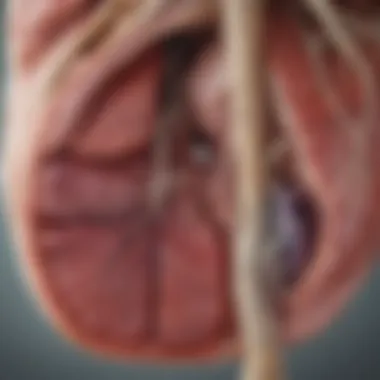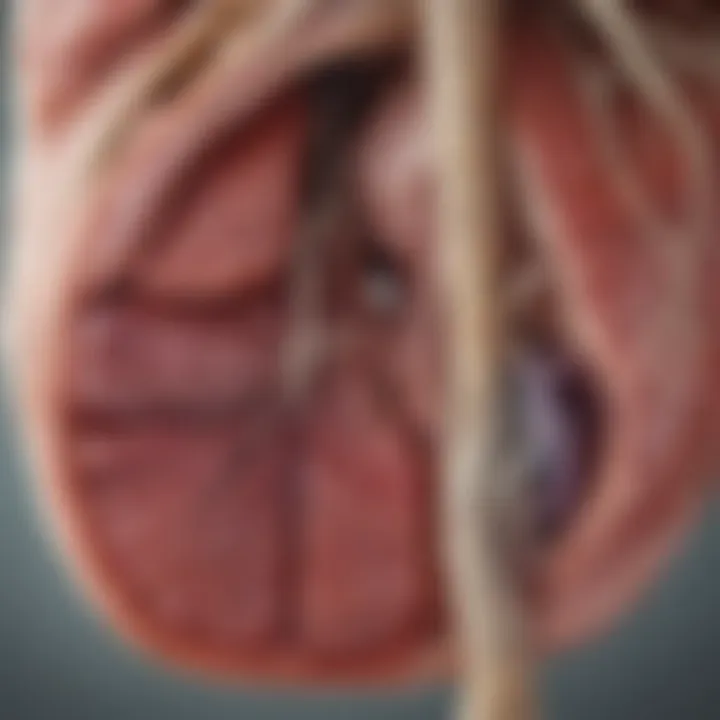Comprehensive Overview of the Liver: Its Role and Health


Intro
The liver is a vital organ in the human body, serving numerous essential functions that are crucial for overall health. As the largest internal organ and one of the most complex, it plays a pivotal role in regulating metabolism, detoxifying harmful substances, and producing important proteins. This article will delve into the details of the liver’s structure, functions, and the health implications associated with it.
Understanding the liver is essential for both individuals and health professionals. The liver’s multifaceted operations impact not only metabolic balance but also the body’s response to various toxins and medications. By exploring the liver's anatomy and its diverse roles in the body, we uncover the importance of maintaining liver health through conscious lifestyle choices and preventive measures.
In this article, readers will find a detailed examination of the liver, including its components, functionality, and the consequences of liver diseases. We will also discuss how different lifestyle factors, such as diet, alcohol consumption, and exercise, can significantly affect liver health. Moreover, the article will provide insights into potential areas for future research, highlighting the ongoing discoveries in liver science.
By the end of this piece, readers will possess a clearer understanding of the liver's complexities and the importance of its health in achieving overall wellness.
Prelude to the Liver
The liver is an essential organ that plays significant roles in human physiology. Understanding its structure and functions can shed light on various aspects of health and wellness. This section aims to explore the importance of the liver and the impact it has on overall bodily functions. By appreciating the liver's complexities, we can better grasp how lifestyle choices and health conditions can affect this critical organ.
Importance of the Liver in Human Physiology
The liver is often referred to as the body's biochemical factory. It performs a vast array of functions that are vital to maintaining homeostasis. One of its primary roles is to regulate blood sugar levels through glucose metabolism. The liver stores excess glucose and releases it when the body requires energy. Additionally, it is integral to fat metabolism. The organ produces bile, which is essential for digesting fats and absorbing fat-soluble vitamins.
Furthermore, the liver detoxifies harmful substances from the blood. It converts ammonia, a byproduct of protein metabolism, into urea, which the body can eliminate easily. This detoxification process is crucial for preventing toxic accumulations that can lead to serious health issues. The liver also synthesizes proteins needed for blood clotting and carries out various functions related to immune system regulation.
Historical Perspectives on Liver Research
Research on the liver has a rich history that extends back to ancient civilizations. The understanding of liver function has evolved significantly over centuries. Ancient Egyptians viewed the liver as the seat of the soul, attributing it with significant spiritual importance. In classical medicine, figures like Hippocrates and Galen contributed to foundational knowledge about liver diseases, although their understandings were largely limited compared to today’s science.
With advancements in anatomy and physiology during the Renaissance, researchers began to examine the liver more systematically. The advent of modern medical imaging techniques and biochemistry has transformed liver research. These developments have enabled scientists to identify liver diseases more accurately and understand the organ's vital roles in various metabolic pathways. Continuous ongoing research offers promising insights into liver health, revealing the organ's complexities and its impact on overall health.
Anatomical Structure of the Liver
Understanding the anatomical structure of the liver is vital to appreciate its functions and the impact of liver diseases. The liver, a large organ located in the upper right abdomen, is divided into specific lobes and segments, ensuring efficient operation of its numerous tasks.
Liver Lobes and Segments
The liver is divided into two main lobes: the right lobe and the left lobe. Each lobe is further segmented into smaller units called lobules. Lobules are functional units of the liver that consist of hepatocytes, the main liver cells.
- Right Lobe: Larger than the left, it comprises about 60% of the liver’s volume.
- Left Lobe: Smaller and located on the left side of the body.
Each lobe is organized in a way that allows efficient blood flow and bile production. This segmentation ensures that each part of the liver can perform its respective functions, including metabolism, detoxification, and bile secretion.
Vascular Supply and Drainage
The liver has a unique and complex vascular system. It is supplied by two major blood vessels: the hepatic artery and the portal vein.
- Hepatic Artery: Supplies oxygen-rich blood directly from the heart to the liver. It is essential for the proper function of liver cells.
- Portal Vein: Carries nutrient-rich blood from the gastrointestinal tract and spleen to the liver. This is crucial for processing nutrients from food.
The liver drains blood through the hepatic veins, which empty into the inferior vena cava. This special arrangement allows the liver to filter and process substances from the blood before they reach the heart.
Biliary Tree and Gallbladder Function
The biliary tree consists of a network of ducts that transport bile from the liver to the gallbladder and duodenum. Bile is a substance that helps digest fats. The gallbladder is a small organ that stores bile and releases it into the small intestine when needed.
Key components of the biliary system include:
- Hepatic Ducts: Carry bile away from the liver.
- Cystic Duct: Connects the gallbladder to the common bile duct.
- Common Bile Duct: Transports bile to the small intestine.
The functionality of the biliary system is important for digestion and absorption of fats, highlighting the liver’s essential role in maintaining digestive health.
"The liver’s anatomical structure is designed to maximize its functional capabilities, ensuring it plays a central role in overall health."
Thus, comprehending the liver's anatomy provides insight into how its structure supports myriad physiological functions. This understanding is critical for both health professionals and individuals seeking to maintain liver health.
Primary Functions of the Liver
The liver performs vital functions essential for maintaining overall health. Its diverse roles extend into various metabolic pathways, making it a central hub for physiological processes. Understanding these functions is fundamental because they highlight how crucial the liver is to homeostasis and wellness. Specific elements in liver functionality include its metabolic role, detoxification processes, protein synthesis, and its involvement in digestion. Focusing on these aspects reveals the significance of liver health in preventing disease and promoting longevity.
Metabolic Role: Glucose Homeostasis


One of the liver's primary functions is its role in maintaining glucose homeostasis. The organ effectively manages blood sugar levels, which is essential for providing energy to cells throughout the body. When blood sugar levels rise, such as after a meal, the liver stores excess glucose in the form of glycogen through a process called glycogenesis.
Conversely, when energy is needed, the liver converts glycogen back into glucose through glycogenolysis. In addition, the liver can produce glucose from non-carbohydrate sources like amino acids and glycerol in a process known as gluconeogenesis. This balance between storage and release is crucial for preventing conditions such as hypoglycemia and hyperglycemia.
Detoxification Processes
The detoxification processes of the liver are vital for filtering the blood and removing harmful substances. The liver processes drugs, alcohol, and environmental toxins, converting them into less toxic forms that can be excreted from the body. Hepatocytes, the liver's main cell type, contain enzymes that facilitate these detoxification reactions.
Through phase I and phase II reactions, the liver can metabolize substances and conjugate them to increase solubility. This ensures that toxins are adequately removed through urine or bile. A properly functioning liver is thus crucial for detoxification, highlighting the risks of liver diseases that can impair this function.
Synthesis of Proteins and Other Biomolecules
The liver also plays an integral role in synthesizing proteins and other biomolecules essential to health. One of the primary products is albumin, the most abundant protein in blood plasma. Albumin maintains oncotic pressure and transports various substances through the bloodstream.
Additionally, the liver is responsible for synthesizing clotting factors necessary for blood coagulation. This function underscores the liver's importance in preventing excessive bleeding and ensuring proper wound healing. Other biomolecules synthesized by the liver include bile acids, which aid in digestion, and various lipids involved in energy metabolism and cell membrane integrity.
Role in Digestion and Nutrient Absorption
Lastly, the liver is critical in digestion and the absorption of nutrients. It produces bile, which is stored in the gallbladder and released into the intestines to emulsify fats. This emulsification action enhances the absorption of dietary fats and fat-soluble vitamins.
Moreover, the liver processes nutrients absorbed from the gastrointestinal tract. After a meal, the liver receives nutrient-rich blood from the portal vein, enabling it to regulate and distribute essential nutrients as needed. This function prevents nutrient deficiencies and supports overall metabolic balance.
The liver's multifaceted functions extend far beyond detoxification. Its role in metabolism, protein synthesis, and digestion illustrates its integral part in health management.
Common Liver Diseases
Understanding common liver diseases is essential for the awareness of liver health and its implications for overall well-being. Liver diseases can have serious consequences, affecting metabolic functions, detoxification processes, and the synthesis of vital proteins. This section discusses prevalent liver ailments, illuminating their causes, symptoms, and potential consequences. The more one knows about these diseases, the better equipped they become for prevention and management.
Hepatitis: Types and Causes
Hepatitis refers to inflammation of the liver, which can arise from various sources. There are several types of hepatitis, characterized by their etiology and mode of transmission. The main types include:
- Hepatitis A: Caused by the Hepatitis A virus, often transmitted through contaminated food and water. It typically results in an acute infection that can resolve on its own.
- Hepatitis B: This type is caused by the Hepatitis B virus. It can lead to both acute and chronic infections. Transmission usually occurs via blood, sexual contact, or from mother to child at birth.
- Hepatitis C: Primarily spread through blood-to-blood contact, often associated with sharing needles. This type can also progress to chronic disease, leading to severe liver damage over time.
- Autoimmune Hepatitis: In this condition, the body’s immune system attacks liver cells, leading to inflammation. The exact causes are not well understood but may involve genetic and environmental factors.
Infection prevention strategies, like vaccination for Hepatitis A and B, are crucial for reducing the risk.
Fatty Liver Disease: Understanding NAFLD
Non-Alcoholic Fatty Liver Disease (NAFLD) is a common condition characterized by excess fat accumulation in the liver. Unlike alcoholic liver disease, NAFLD occurs in individuals who consume little to no alcohol. The disease can range from simple steatosis to more severe forms like Non-Alcoholic Steatohepatitis (NASH), which involves liver inflammation and damage. Risk factors include:
- Obesity: A primary contributor.
- Type 2 diabetes: Significantly increases risk.
- High cholesterol: Often coexists with fatty liver disease.
- Sedentary lifestyle: Physical inactivity can exacerbate this condition.
Management often involves lifestyle modifications, including weight loss and dietary changes aimed at reducing liver fat. Early diagnosis is key to preventing progression to more serious liver conditions.
Cirrhosis: Progression and Consequences
Cirrhosis refers to the scarring of the liver caused by long-term liver damage. Various conditions such as chronic hepatitis, excessive alcohol consumption, and non-alcoholic fatty liver disease can cause cirrhosis. As cirrhosis advances, healthy liver tissue is replaced by scar tissue, impairing liver function. Common consequences include:
- Portal hypertension: Increased blood pressure in the liver's blood vessels.
- Liver failure: Severe cases lead to the liver's inability to perform vital functions.
- Increased risk of liver cancer: Especially in late stages of cirrhosis.
Management typically focuses on slowing the progression and addressing the underlying cause. In severe cases, a liver transplant may be necessary.
Liver Cancer: Risk Factors and Detection
Liver cancer is among the most serious outcomes of chronic liver disease. It often develops in individuals with cirrhosis or chronic viral hepatitis. Recognized risk factors include:
- Chronic hepatitis B or C infection: Significantly raises cancer risk.
- Cirrhosis: A common precursor to liver cancer.
- Excessive alcohol consumption: Can lead to liver damage over time.
Detection methods for liver cancer include imaging tests like ultrasound, CT scans, and MRI. Blood tests to measure alpha-fetoprotein levels can also aid in early identification. Timely detection enhances treatment options and improves prognosis.
Autoimmune Liver Diseases
Autoimmune liver diseases occur when the body's immune system mistakenly targets liver cells, leading to inflammation and damage. The most common form is autoimmune hepatitis, but there are other conditions such as Primary Biliary Cholangitis and Primary Sclerosing Cholangitis. Symptoms can be vague and include fatigue, jaundice, and abdominal discomfort. Treatment typically involves medications to suppress the immune response and manage symptoms, but chronic cases can necessitate liver transplantation.
Impact of Lifestyle on Liver Health
The impact of lifestyle on liver health cannot be overstated. The liver is responsive to various factors, notably diet, alcohol consumption, and physical activity. Poor choices in these areas can lead to liver diseases and compromise its essential functions. Therefore, understanding how lifestyle affects this organ is fundamental for individuals seeking to maintain health and prevent diseases.


Dietary Considerations for Liver Maintenance
Diet plays a pivotal role in the proper functioning of the liver. A balanced diet nourishes this organ and helps in its detoxifying tasks. Specific dietary considerations include:
- Incorporating fruits and vegetables: These foods are rich in antioxidants, which help combat oxidative stress in the liver. Eating a variety provides essential vitamins and minerals necessary for liver repair.
- Choosing healthy fats: Opt for sources of unsaturated fats like olive oil, nuts, and avocados. Avoid trans fats often found in processed foods, as they can exacerbate inflammation and fat accumulation in the liver.
- Limiting sugar and salt: Excessive sugar promotes fat buildup in the liver, which can lead to fatty liver disease. Reducing salt intake is also crucial in managing blood pressure, which indirectly benefits liver health.
- Adequate protein intake: Protein helps in the formation of enzymes and tissues crucial for liver function. Lean meats, fish, and legumes are good sources.
- Staying hydrated: Consuming plenty of water aids in the liver's detoxification processes. It helps in flushing out waste products and supports overall metabolic functions.
Alcohol Consumption: Guidelines and Risks
Alcohol significantly influences liver health. While moderate consumption may not pose serious risks for some individuals, excessive intake leads to numerous health issues.
- Guidelines: Medical professionals often recommend limits on alcohol consumption. For instance, most guidelines suggest that men should limit intake to two standard drinks daily while women should limit it to one.
- Risks of Excessive Consumption: Chronic alcohol abuse can lead to liver inflammation, fatty liver disease, and eventually cirrhosis. Moreover, even moderate drinkers should be aware of their body's responses, as individual tolerance can vary greatly.
"Drinking in moderation is crucial. The liver’s ability to regenerate is remarkable but not limitless. Protecting it is vital for overall health."
Understanding the risks and adhering to guidelines is essential for preventing alcohol-related liver diseases.
Exercise: Its Role in Liver Function
Regular physical activity is fundamentally important for liver health. Exercise not only promotes weight management but also directly impacts liver function in several ways:
- Weight management: Being overweight is a significant risk factor for nonalcoholic fatty liver disease. Regular exercise helps to control body weight, reducing fat deposits in the liver.
- Improved metabolism: Performing aerobic exercises, such as running or swimming, can enhance metabolism, leading to better regulation of blood sugar levels and lipid profiles. This is crucial for maintaining liver health.
- Enhanced blood circulation: Physical activity promotes better blood flow to the liver. Improved circulation helps the organ regenerate and perform its essential functions effectively.
- Stress reduction: Exercise helps in reducing stress, which has been shown to improve liver function and overall health.
Engaging in regular physical activity should be viewed as a central aspect of a healthy lifestyle that fosters liver maintenance.
In summary, the lifestyle choices individuals make profoundly affect the liver’s health and efficiency. Emphasizing a balanced diet, sensible alcohol consumption, and regular exercise can yield significant long-term benefits.
Diagnostic Approaches for Liver Conditions
Diagnosing liver conditions accurately is crucial for effective treatment and management. The liver is central to many metabolic processes, and its dysfunction can lead to a wide range of health issues. There are multiple methods to assess liver health, each contributing valuable insights into the organ's condition. Understanding these diagnostic approaches is important for students, researchers, and professionals in the medical field. This section will elaborate on essential diagnostic strategies, emphasizing their significance in liver health assessment.
Laboratory Tests: Biochemical Markers
Laboratory tests are often the first step in diagnosing liver issues. They typically involve blood tests that evaluate various biochemical markers. Key indicators include alanine aminotransferase (ALT), aspartate aminotransferase (AST), alkaline phosphatase (ALP), and bilirubin levels.
- ALT and AST: These enzymes are released into the bloodstream when liver cells are damaged. Elevated levels often indicate liver injury.
- ALP: High levels may suggest obstruction of bile flow or liver disease.
- Bilirubin: Elevated bilirubin can indicate issues with liver function or bile excretion.
These tests provide essential information, allowing doctors to gauge liver function. However, the interpretation of these results must be done carefully, considering other factors such as medications and comorbidities.
Imaging Techniques: Ultrasound and Beyond
Imaging techniques play a crucial role in visualizing liver structure and detecting abnormalities. The most common imaging methods include ultrasound, computed tomography (CT), and magnetic resonance imaging (MRI).
- Ultrasound: This is often the first imaging test performed. It is non-invasive and can detect liver size, the presence of cysts, tumors, or fatty changes.
- CT Scans: These provide detailed cross-sectional images of the liver, useful for identifying tumors or structural changes.
- MRI: This technique may be utilized for better soft tissue contrast, especially in complex situations like assessing liver lesions.
Each imaging modality has its advantages and limitations. Ultrasound is widely available and cost-effective, while CT and MRI offer more detailed visualization. Clinicians choose the appropriate method based on the clinical scenario.
Biopsy: When and Why It Is Necessary
Liver biopsy is a critical procedure, often reserved for cases where imaging and blood tests do not provide definitive answers. It involves extracting a small sample of liver tissue for examination.
- Why Biopsy?: The biopsy helps to determine the cause of liver diseases like hepatitis, cirrhosis, and tumors. It allows pathologists to assess the tissue's histology in detail.
- When Is It Necessary?: Biopsy is typically considered when there are unexplained liver enzyme elevations, if imaging reveals abnormalities, or when differential diagnosis is problematic.
However, biopsy results must be interpreted judiciously. They can provide insights about inflammation, fibrosis, or cancer but carry risks such as bleeding and infection. Thus, careful consideration is necessary when suggesting this approach.
Accurate diagnostic evaluations are paramount in managing liver health effectively.
Gathering comprehensive diagnostic information helps in formulating treatment plans and enhances the understanding of liver diseases. By combining biochemical tests, imaging techniques, and, when necessary, biopsy results, healthcare providers can achieve a clearer picture of liver health.
Current Trends in Liver Research
Recent advancements in liver research represent a significant shift in how medical communities address liver-related health concerns. Proper understanding of these trends is vital, not just for academics but also for healthcare professionals and patients seeking innovative treatments. The liver's complexity demands continuous exploration, revealing new therapeutic avenues, enhanced diagnostic tools, and a better grasp of emerging health implications.
Emerging Treatments for Liver Diseases
Developing new treatments for liver diseases is of paramount importance given the increasing incidence of conditions like hepatitis, cirrhosis, and liver cancer. Novel pharmacological approaches are being designed to target specific pathways in liver diseases, offering potentially effective alternatives to traditional therapies. Recent studies highlight the effectiveness of direct-acting antivirals for hepatitis C, which significantly improve cure rates and reduce the need for liver transplant.


In addition to drugs, new treatment modalities include:
- Monoclonal Antibodies: Tailored to target specific liver disease mechanisms.
- Small Molecules: These can disrupt disease progress at a metabolic level.
- Immunotherapies: Strategies are being tested that harness the body's immune response to fight liver cancer more effectively.
Gene Therapy and Regenerative Medicine
Gene therapy stands as an exciting frontier in liver research. This approach aims to correct genetic defects or modulate gene expression related to specific liver diseases. Research focuses on various viral vectors that deliver therapeutic genes directly to the liver, offering a chance for long-term remission in conditions like hemophilia and hereditary hemochromatosis.
Regenerative medicine also offers significant promise. Scientists investigate techniques to enhance the liver's capacity for self-repair, such as stem cell therapies and tissue engineering. These methods seek to regenerate damaged tissue or even grow liver tissues for transplant. The ability to regenerate liver function could lead to revolutionary changes in how liver diseases are managed.
The Role of Artificial Intelligence in Diagnosis
Artificial intelligence (AI) plays a transformative role in diagnosing liver conditions. The enormous volume of data generated in medical research makes conventional analysis challenging. AI algorithms can process vast datasets swiftly, identifying patterns correlated with liver diseases that would be nearly impossible for humans alone to detect.
Key areas of AI application in liver research include:
- Image Analysis: AI can analyze imaging studies to detect liver abnormalities early and accurately.
- Predictive Modeling: Algorithms can predict disease progression based on historical data, allowing for timely interventions.
- Biomarker Discovery: AI is used to identify new biomarkers for liver disease, facilitating earlier and more accurate diagnoses.
Understanding these trends not only enhances clinical outcomes but also paves the way for a preventative approach towards liver health.
In summary, the current trends in liver research indicate a promising horizon. With emerging treatments, genetic advancements, and AI integration, the landscape of liver health is transforming. The implications are profound, influencing not only patient care but also the future of medical research.
Preventive Measures for Liver Health
Preventive measures for liver health are crucial. The liver, as a central organ in metabolic processes, needs constant care to function at its optimal level. Issues with the liver can lead to severe health complications. This section highlights two key areas in liver prevention strategies: vaccinations and regular health screenings.
Vaccinations and Preventive Care
Vaccinations play a vital role in protecting liver health. Vaccines can prevent certain types of hepatitis. Hepatitis A and B are notable examples. Hepatitis A vaccine is essential for travelers to regions with poor sanitation. It is effective in stoping viral infections from contaminated food and water.
Hepatitis B is more serious. The vaccine provides long-lasting protection. It is especially important for healthcare workers and those with multiple sexual partners. Educating people about vaccines is essential. Understanding the need for these vaccinations can lead to better public health outcomes.
Beyond vaccines, preventive care includes receiving regular check-ups. This allows for early detection of liver problems. Programs promoting education about liver diseases are also crucial.
Regular Health Screenings and Monitoring
Regular health screenings are a pillar of preventive care for liver health. Tests that measure liver function can detect issues early. Blood tests such as liver enzyme tests provide important biomarkers. They help determine the presence of underlying liver diseases.
Routine check-ups can include imaging techniques. Ultrasounds and CT scans can visualize liver size and structure. Such exams are valuable for identifying abnormalities.
Another critical aspect is monitoring risk factors. For instance, individuals with obesity or diabetes must undergo frequent liver assessments. Awareness of one’s family history of liver disease is also significant.
As a takeaway, preventive measures are not just about individual responsibility.
"Community health initiatives can strengthen preventive care through education and access to resources."
Adopting a holistic approach to liver health is beneficial. By investing time and energy in vaccines and screenings, one can greatly enhance their liver health and overall well-being.
Closure: Understanding the Liver's Role
The liver is often regarded as one of the most vital organs in the human body. This section offers a concluding perspective on its various roles and functions, emphasizing its importance in maintaining overall health. Understanding the liver's operations can lead to better health choices and improved preventive measures against diseases.
One significant aspect is that the liver plays a central role in metabolic processes. It regulates glucose levels, stores vitamins, and produces essential proteins. This equilibrium is crucial for the body's functioning. Any disturbance in liver function can lead to serious health implications.
Moreover, the liver aids in detoxifying harmful substances. It neutralizes toxins and processes medications, which is essential for the body to eliminate waste. By understanding the liver's detoxification capacity, individuals can better appreciate the need for lifestyle changes that promote liver health.
Preventive measures are paramount in safeguarding the liver. Awareness of potential diseases and understanding symptoms can lead to timely diagnosis and treatment. Regular check-ups and health screenings can detect issues early, enhancing the chances for effective treatment.
In summary, the liver is not just a metabolic powerhouse but a critical organ linked to detoxification and the maintenance of homeostasis.
"Keeping the liver healthy can prevent a multitude of diseases and promote overall wellness."
Key Takeaways for Healthier Living
- Balanced Diet: A diet rich in whole foods, including fruits, vegetables, and healthy fats, supports liver function. Reducing processed foods is also beneficial.
- Avoid Excess Alcohol: Limiting alcohol consumption lowers the risk of liver diseases, including fatty liver and cirrhosis.
- Regular Exercise: Engaging in physical activity helps maintain a healthy weight, which is important for preventing fatty liver disease.
- Routine Check-Ups: Regular medical examinations and liver function tests can help detect potential liver issues before they become serious.
- Stay Hydrated: Drinking adequate water aids in metabolic processes and supports kidney function, indirectly benefiting liver health.
Future Perspectives on Liver Research
Research into liver health is rapidly evolving, promising new insights and treatments. Future studies may focus on the following areas:
- Novel Therapeutics: Advances in drug development aim to target specific liver diseases more effectively. This may include personalized medicine tailored to individual genetic profiles.
- Gene Therapy: Research into gene editing technologies, like CRISPR, has the potential to address inherited liver disorders at their source, offering hope for affected individuals.
- Artificial Intelligence: The implementation of AI in medical diagnostics may improve the accuracy and speed of liver disease detection, aiding in early intervention.
- Lifestyle Medicine: A growing emphasis on integrating lifestyle changes into medical treatment may lead to tailored programs that focus on diet and exercise.
Continued exploration in these areas could enhance our understanding of liver functions and health, paving the way for innovative strategies to tackle liver diseases.







